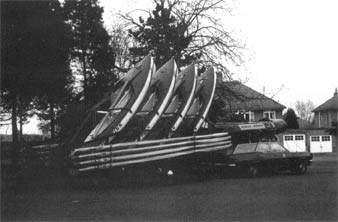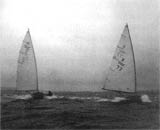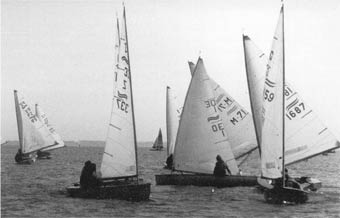|
|
However
most of the top helmsmen had no experience with the new
material and wooden masts were still considered to be
faster.
Jorg Bruder won the Gold Cup for the second time with
a wooden spar. The IFA Honorary Secretary Heidi Auer was
in favour of wooden masts. She claimed that aluminium
masts would give the British sailors an unfair advantage. |
The IYRU had agreed to use metal masts at the Olympics,
upon request of the German organiser of the Olympics
as suggested by IFA President Vernon Stratton and
the Chairman of the Technical Committee Gilbert
Lamboley. However IFA secretary/treasurer Heidi
Auer was fighting to have this decision cancelled
again. A strange extraordinary AGM in Athens called
too late on the spot by the Auers on the occasion
of the European Championship elected Dr. Fred Auer
as the new President of IFA and reversed the decision
of the former president to use aluminium masts at
the 1972 Olympics. Vernon Stratton declared that
AGM to be illegal and insisted to remain the duly
elected president of IFA.
The official AGM on the occasion of the Gold Cup
in Toronto approved a new constitution and the selection
of aluminium spars for the 1972 Olympics. Hans van
Elst from Holland was elected the new president
of IFA and a completely new team took over the helm.
|
 |
4
of the 10 Finns that were provided for
the 1968 UK Olympic Trials |
|
Ken Ryan from Ireland was elected Honorary Secretary to
be supported by a paid assistant and a professional accountant.
As Mr. Achermann from the Swiss Credit Bank in St. Moritz
was already acquainted with the work, it was decided to
have him carry on. Carl van Duyne (USA) was elected as
the first Vice President (Sailing) and Andy Zawieja (Poland)
as Vice president (Administration). Gilbert Lamboley was
the only member of the old team to survive the revolution
as the Chairman of the Technical Committee. The father
of Serge Maury (France), Mr. Raymond Maury kindly agreed
to do FINNFARE in the future in form of a bimonthly bulletin,
however not a single copy of that publication survived
in any archive. Independent from these administrative
scandals the Finn Class prospered and Jorg Bruder won
his second Gold Cup in Toronto. |
1972
When Jorg Bruder won his third Gold Cup with his
own aluminium mast the former opposition of the
top helmsmen against the new material melted. After
several trials and errors the Needlespar M turned
out to be the spar for the years to come.
By 1972 Gilbert Lamboley had introduced his revolutionary
concept to control the distribution of matter in
a Finn dinghy. For one year this system was used
parallel to the old system to control the centre
of gravity.
|
 |
|
At
the 1972 AGM the new Honorary Secretary Kenneth Ryan was
not able to clarify the accounts he had inherited from
the former executive officers of the IFA. It was felt
that an additional position should be created to take
care of the financial matters and Peter Roost from Switzerland
was elected the first treasurer of IFA. Against the decision
of the IFA AGM not to control the weight of wet clothing
at all, the IYRU decided in November 1972 to limit the
maximum to 20 kg. |
|
|
construction.
So the IYRU agreed to allow any material for the construction
of the hull and to introduce double bottoms. Therefore
the Finn remained the most modern dinghy for top competitive
sailing.
In 1973 the Finn Class suffered a severe loss from the
human, sporting and technical point of view, when Jorg
Bruder was killed in an airplane crash on route to the
Gold Cup in Brest to defend his title.
Because of an increasing income from the sale of rule
books and sail labels the financial situation of the IFA
improved considerably. The IYRU put pressure on the IFA
to limit the number of participants in the Gold Cup to
about 60 boats. However the AGM voted clearly in favour
of adhering to the established quotas and the entry system
remained in principle unchanged, allowing for far more
than 100 boats. In order to encourage organisational efforts
in each country, national Finn secretaries were allowed
to enter the Gold Cup above the quota of their country.
This also increased the number of qualified delegates
to the AGM. |
1974
In accordance with the new rales a new rale book
was printed in 1974. The first builder to take advantage
of the new rales was Peter Taylor in Great Britain.
He produced a good looking hull with a double bottom,
which sailed very dry and turned out to be fast
especially downwind. However after some time the
majority of the Taylor boats started to leak at
the joint of the hull with the deck. Gilbert Lamboley
contributed further to the improvement of the IFA
finances through the production and sale of new
templates that he had produced with a computer controlled
milling machine. The aluminium masts introduced
in 1972 caused safety problems in a capsize and
it was agreed to require all masts to be watertight
and float. However within two years it became obvious
that this rale resulted in trapping water in the
mast rather than keeping it out and therefore the
rale was abandoned again in 1977.
|
 |
|
1975
Four years after the turmoil of Toronto the turn of Hans
von Elst from Holland as president was over and the AGM
in Malmo, Sweden peacefully elected Marino Barendson from
Italy as the new president and Nikos Kouklelis from Greece
as Honorary Secretary. Barendson, who had never sailed
a Finn in his life, thought to benefit the Class by making
it more modern. He travelled on his expenses all over
the world to push for a reduction of the hull weight and
to support experiments. Barendson's well meant but uncoordinated
actions were curbed by the Chairman of the Technical Committee
Gilbert Lamboley, who successfully guarded the one-design
character of the Finn Class. No substantial rale changes
were even proposed to the IYRU.
Gilbert Lamboley also managed to obtain a new Gold Cup
from Somms Marine, after the original Cup had been lost
in that tragic air crash of Jorg Bruder in 1973. Another
effort was made to control pumping. However it was not
possible to bring the diverging opinions from sailors
on flat and open waters closer together. In spite of that
some countries included in their sailing instructions
the requirement of a minimum three rope purchase through
the floor block except when gybing.
1976
As a reaction to the difficulties with the selection of
the Olympic masts in 1972, the participants in the 1976
Olympics in Kingston, Canada were allowed to bring their
own spars and sails. The majority of the sailors would
have preferred to use their own boats complete. A second
edition of the new rale book was printed in 1976 with
very little changes compared to the 1974 edition.
Since the 1976 Gold Cup took place in January in Australia,
the 1976 AGM was divided into two sessions, one at the
Gold Cup the other at the European Championship in France
in May. The Council of the IFA called the attention of
all present and future IFA Executive Committees to the
need to coordinate their individual efforts with the other
members of the Executive Committee and the relevant committees.
By 1976 a negative side-effect of the Lamboley test upon
the development of the Finn Class was observed. Some builders
emphasised top speed too much and neglected seaworthiness
by constructing extremely thin weak hulls and using more
lead than plastic. Some boats sank to the bottom of the
sea and sailors were in severe peril. However the problem
solved itself inasmuch as the respective makes fell into
discredit among the sailors despite the speed advantages.
The Finn Class turned out to be rather reluctant to accept
the recommendations of the IYRU regarding the old problem
of pumping.
|